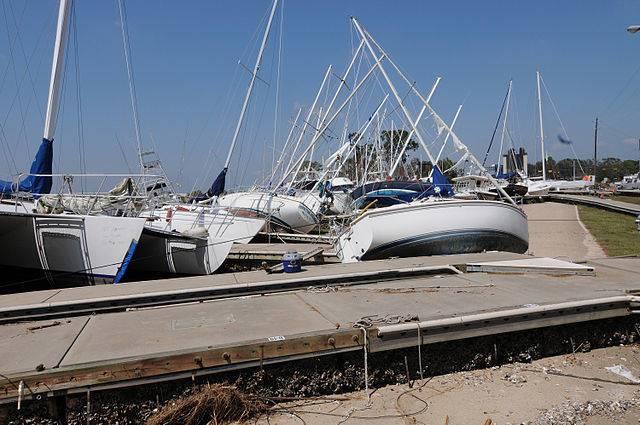
In 2001, after Tropical Storm Allison pummeled the Houston area and shut down its 700-acre Texas Medical Center, officials went to work to develop a climate mitigation plan.
But with all of the complexities inherent in protecting an oil industry hub that considers itself the “energy capital of the world,” developing climate resilience for Texas' coastline and nearby metropolitan areas has been especially challenging. The Houston area sustained multiple direct hits from storms in the last 15 years, including a 2015 cyclone that resulted in $50 million in damages to Texas residences and businesses.
But the city launched a pilot mitigation plan in 2014 with the help of the Federal Emergency Management Agency (FEMA). The plan was coordinated through the Johnson Space Center, which sits outside of Houston and has a vested interest in bolstering climate mitigation.
Data from the Department of Agriculture, the U.S. Army Corps of Engineers and the U.S. Geological Survey were used to compile a sustainability plan that included options for climate change adaptation. Other sources like NASA’s Climate Risk Management Plan, the Climate Projection Portal and the Coastal Adaptation Toolkit were also incorporated into the project.
While project leaders say the efforts helped protect investments during record-breaking storms last year, Houston remains an example of the deep divide between climate change mitigation policies and reality.
The reality is that scientists consider carbon emissions to be part and parcel of the city’s burgeoning climate problems. By 2020, the median temperature is expected to rise as much as 2.5 degrees over its baseline of 70.5 degrees Fahrenheit; by the end of the century, the projected number of days above 95 degrees will be more than double what it was in 2016. And just as striking are the projections for emissions in the Houston area, where oil production and shipment is a governing industry for the Texas economy.
Last year that divide was most evident in the presidential elections, where the majority of Harris County’s 4.3 million residents voted for Hillary Clinton. (Harris County contains Houston, as well as surrounding suburbs like Pasadena and Baytown.) The tally was as much a statement against the Republican candidate’s plan to eviscerate the climate change policies that were helping to save their city as recognition that climate mitigation, when strengthened by clear data and collaborative efforts, does work.
In November 2016, the National Oceanic and Atmospheric Administration (NOAA) released yet another tool for cities like Houston to use: an updated and largely improved version of its 2014 Climate Explorer.
The website, which is coordinated through the U.S. Climate Resilience Toolkit, reinforces much of what Houstonians have experienced so far: Following the projected course of global warming, Houston -- which sits 80 miles from the Texas coast and a precarious 6 feet above sea level in flat terrain -- is in for even more climate shakeup.
It’s a tool that could also benefit other Texas cities such as Galveston, which sits in an even more precarious location on the state's scenic coastline. The county voted overwhelmingly for Donald Trump, even though Galveston residents say there is an alarming need to address sea-level rise.
And that isn’t the only thing that residents may find alarming in future years. The affluent community, known for its picturesque and island-like setting, is due for a monumental change in temperature in the coming years, if global warming isn’t under control. Climate data for the last five or 10 years has been deceptively “flat” but by 2030, analysts say, that vacation will be over. By 2100, the number of days sporting 95 degrees or greater are expected to increase tenfold unless state and federal policies begin to adopt climate mitigation options.
The new version of the Climate Explorer allows users to search by county, city and ZIP code, and to zero-in on specific climate and environmental risks so that counties like Galveston and Harrison, Mississippi -- which both voted for Trump overwhelmingly -- can understand why scientists feel climate should be an actionable issue.
In Biloxi, Mississippi, the county seat of Harrison, two organizations, the locally-based Coastal Hazards Outreach Strategy Team and the Mississippi-Alabama Sea Grant attempted to further that information by providing informational displays in a local shopping center. Visitors could see flooding projections for their neighborhoods and learn about sea-level rise and what it means for inland waterways. The Climate Explorer offers visual cues and methods for objectively strategizing options communities can take.
NOAA’s software isn’t meant to impart a political message about the ramifications of a viewer’s vote, but its projections do beg the question: Will communities like Galveston and Biloxi be safer if President Trump is able to strip climate action from the federal government’s to-do list?
And it’s a question that counties across the country, from California to New Hampshire, may be asking themselves in coming months, or possibly years. Tools like the Climate Explorer, however, may give them at least a starting point for realizing that politics doesn’t have to get in the way of addressing climate change.
Image: Wikimedia/Walter Jennings/FEMA
Jan Lee is a former news editor and award-winning editorial writer whose non-fiction and fiction have been published in the U.S., Canada, Mexico, the U.K. and Australia. Her articles and posts can be found on TriplePundit, JustMeans, and her blog, The Multicultural Jew, as well as other publications. She currently splits her residence between the city of Vancouver, British Columbia and the rural farmlands of Idaho.














